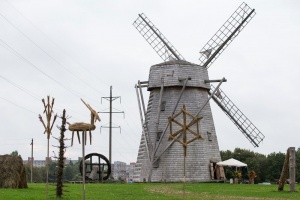 |
| Šiauliai Cathedral |
How do I arrive to Šiauliai?
Šiauliai is an important city so there are many way to arrive there from all over Lithuania.
- Train: there are train routes to Panevėžys (aprox. 1.5 hours), to Klaipėda (aprox. 2.5 hours) and to Vilnius (aprox. 3 hours), among other destinations.
- Bus: there are from Šiauliai at least 15 buses to Panevėžys (aprox. 1 hour 30 minutes), frequent buses to Kaunas (aprox. 2 hours 45 minutes; 10€, one way), Klaipėda (aprox. 3 hours) and Vilnius (aprox. 3 hours 45 minutes). As an important city it has connections with Riga (4 buses, aprox. 2.5 hours).
- Car: if you rented a car, Šiauliai can be reached from Šeduva (aprox. 40 minutes), Smilgai (aprox. 45 minutes), Panevėžys and Telšiai (aprox. 1 hour), from Kaunas and Klaipėda (aprox. 2 hours) and from Vilnius (aprox. 2.5 hours). Šiauliai can also be reached from places in Latvia like Jelgava (aprox. 1 hour 10 minutes), Bauska and Dobele (aprox. 1 hour 20 minutes), Riga (aprox. 1 hour 50 minutes) .
History
What can I visit in Šiauliai?
Šiauliai has a nice walk around Vilniaus
gatvė although it isn't a very touristic place. The city has some weird museums that can be visited if interested.
These are Šiauliai's main attractions:- Bicicle Museum (10-18 Tue-Fri, 11-17 Sat; 2€; taking pictures or video costs 5.50€): museum hosts a nice collection of velocipedes and wooden-wheeled bicycles, plus expositions about Lithuanian cyclists.
- Photography Museum (10-18 Tue-Fri, 11-17 Sat; 2€/ 1€ adults/ reduced): museum that is home of a middle 20th century photography exposition plus others temporary ones.
- Chaimo Frenkelio Villa (10-18 Tue-Fri, 11-17 Sat-Sun; 3€/ 1.50€ adults/ reduced; taking pictures or video costs 5.50€): Art Nouveau palace from 1908 built for the Duchy of Šiauliai. It was used during the Sovietic occupation as hospital.
- Cat Museum (10-17 Tue-Fri, 9-16 Sat; 1.50€/ 1€ adults/ reduced): this cat-lovers museum has a collection of objects related to cats, from porcelain cats to a small cats zoo.
- Šiauliai Cathedral: 16th-17th century cathedral in Renaissance and Mannerism styles, whose tower is the 2nd highest of a cathedral in Lithuania, and seat of the diocese of Šiauliai. The church was slightly modified in the 19th century and after the damages suffered during WW2. It's said to have been inspired by the tomb chapel in Château d'Anet designed by Claude de Foucque, near Paris.
- Sundial and Saulės laikrodžio aikštė: monument built in 1986 to conmemorate the Samogitian victory at Saulė Battle, one of the city's icons.
- St. Jurgio Catholic Church: 1909 Catholic church with an important Byzantine style influence.
- Angel Museum (10-18 Mon-Fri; 2€/ 1€ adults/ reduced): curious small museum that exhibits a collection of more than 500 angels gathered by Rytis Milkintas for more than 10 years.
- Žaliūkiai Miller's Homestead (10-18 Tue-Fri, 11-17 Sat; 1€/ 0.50€ adults/ reduced; taking pictures or video costs 5.50€): ethnocultural museum located in the only 19th century Lithuanian wood mill which talks about Lithuanian traditional customs and entertainments.
- Near Šiauliai, 10 km north can be found the touristic and weird place called Hill of Crosses (Kryžių kalnas). It's one of the most visited places in Lithuania, consisting on thousands of crosses (bigger and smaller, wooden or metallic, expensive or cheap) placed by pilgrims. The most common ones are koplytstulpis (wooden sculptures with a small roof) and rūpintojėlis (suffering Christ). The first crosses were placed in the 19th century (as symbol of hope and suffer) but during the Soviet Union they were removed more than once, but being replaced by afterwards by other pilgrims. The Pope John Paul II visited it in 1993 and a monastery was built in 2000.
 | |
| Hill of Crosses |
 |
| Kleboniškiai Rural Life Exhibition |
In the way between Šiauliai and Panevėžys, can be found some interesting places that are worth a visit. Šeduva (Szadów in Polish), a 3,270 inhabitants town that has a nice 17th century Baroque church, St. Kryžiaus Atradimo Catholic Church, with a yellow and white façade. Just 8 km east from Šeduva there's the village of Kleboniškiai (21 inhabitants). Here it can be visited Vėjo malūnas (19th century windmill) and Kleboniškiai Rural Life Exhibition (9-18 Tue-Sun from Apr to Oct; 8-17 Tue-Sat from Nov to Mar; 4€/ 2€/ free adults/ students and kids/ kids under 3), a nice 19th and 20th century beautiful farm that shows the typical Lithuanian rural life with objects and photos. Later on the way to Panevėžys the visitor can stop at Smilgai (Smilgie in Polish), a 544 people village where St. Jurgio Catholic Church is located, a colourful 17th century Baroque church with Rococo altars, considered one of the most beautiful altars made by folk craftsmen in the Baltic countries. Not far from here (10 km by car) it can be found Naudvaris Estate, a 19th century manor which belonged to Kerbedis family.
Where can I eat in Šiauliai?
Šiauliai main places to eat are around Vilniaus
gatvė. In low budget circunstances supermakets food, the cafe ČinČin (Aušros alėja 25) and the pub Kapitonas morganas (Vilniaus
gatvė 183) can be a very nice solution. Otherwise, for a medium price could be CASK 215 (Vilniaus
gatvė 215) or Arkos (Vilniaus
gatvė 213), with a nice value for money.
In Šeduva there's a picturesque restaurant called Šeduvos Malunas (Vytauto gatvė 89a), located in a 20th century windmill.
In Šeduva there's a picturesque restaurant called Šeduvos Malunas (Vytauto gatvė 89a), located in a 20th century windmill.



 14:06
14:06
 Banknotemaniac
Banknotemaniac

 Posted in:
Posted in: